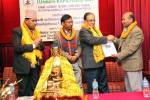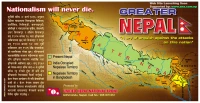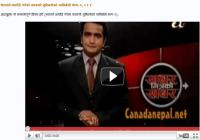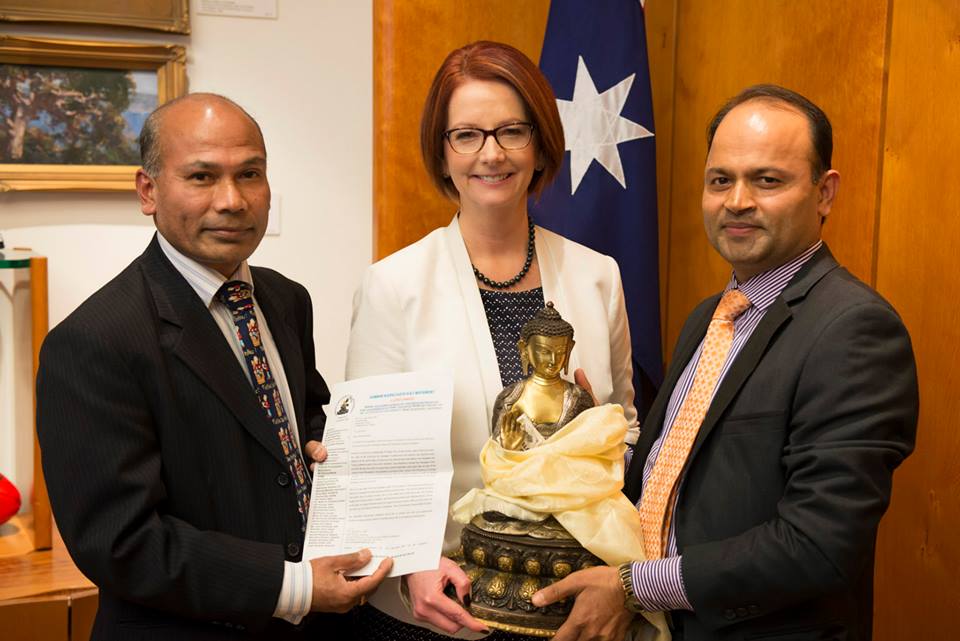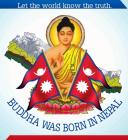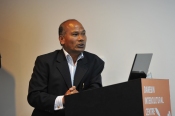के तपाईंले कर्ण शाक्यको बहुचर्चित सोंच पढनु भयो? छैन भने सुन्नुहोस त (श्रोत: खसखस डट कम) :
Archive for February, 2010
कर्ण शाक्यको सोंच
Posted by Ram Kumar Shrestha on February 28, 2010
Posted in Audio, प्रेरणादायी सामग्रीहरु | Leave a Comment »
Hans-Peter Duerr, Ph.D Interview
Posted by Ram Kumar Shrestha on February 27, 2010
This could be important for the student of science, researchers and spiritual persons. Expecting some more concrete outputs from the International conference of scientists Mr Chopra.
Read the Article at HuffingtonPost
Posted in Science &Technology | Leave a Comment »
Isaac Newton on God
Posted by Ram Kumar Shrestha on February 22, 2010
by Lewis Loflin
While revered as one of the greatest scientist of all time, Isaac Newton (1643-1727) wrote more on religion than science. The  fight between secular fundamentalism and Christian fundamentalism rages as both sides seek to bolster a political system by crowning famous people as their own. Was Isaac Newton a Deist or a Christian? The answer is Newton was broadly a Christian Unitarian or rational Christian. He clearly rejected the Trinity and read the Bible in a literal manner (Christians use allegorical), thus removing many of the Greek pantheist and Platonist elements at the core of Christian dogma. See The gospel roots of Christian pantheism.
fight between secular fundamentalism and Christian fundamentalism rages as both sides seek to bolster a political system by crowning famous people as their own. Was Isaac Newton a Deist or a Christian? The answer is Newton was broadly a Christian Unitarian or rational Christian. He clearly rejected the Trinity and read the Bible in a literal manner (Christians use allegorical), thus removing many of the Greek pantheist and Platonist elements at the core of Christian dogma. See The gospel roots of Christian pantheism.
According to At the Origins of English Rationalism by T.E. Wilder he makes it clear “deists are now widely misunderstood, and their views commonly misrepresented. The caricature of deism is of a belief in a ‘clockwork’ making God who sets up the world and then retires to allow it to run unattended…The God of the Deists is often made to appear as the apex of an abstract world-system, a creative being that started the world-process and then withdrew and is now separated and isolated from it; this is the “absentee God” of literature.”
The “God went away” crowd would be better called deistic Humanists or deistic pantheists. The true Deists of the 17th century shared many common beliefs with Christians of the time:
- A rational human nature in a world of natural law where reason apprehends the principles of right conduct and guides the other human faculties,
- A providentially ruling Deity who receives worship and rewards and punishes good and evil conduct,
- A moralism presumed to be supportable from Natural Law. Read the rest of this entry »
Posted in Article | Leave a Comment »
The Power Elite
Posted by Ram Kumar Shrestha on February 21, 2010
By DAVID BROOKS
One of the great achievements of modern times is that we have made society more fair. Sixty years ago, the upper echelons were dominated by what E. Digby Baltzell called The Protestant Establishment and C. Wright Mills called The Power Elite. If your father went to Harvard, you had a 90 percent chance of getting in yourself, and the path upward from there was grooved in your favor.
Since then, we have opened up opportunities for women, African-Americans, Jews, Italians, Poles, Hispanics and members of many other groups. Moreover, we’ve changed the criteria for success. It is less necessary to be clubbable. It is more important to be smart and hard-working.
Yet here’s the funny thing. As we’ve made our institutions more meritocratic, their public standing has plummeted. We’ve increased the diversity and talent level of people at the top of society, yet trust in elites has never been lower. Read the rest of this entry »
Posted in Article | Leave a Comment »
प्रेम दिवस, साहित्य र देशभक्ति भावना
Posted by Ram Kumar Shrestha on February 16, 2010
देश र समाजको लागि अत्यन्तै प्रतिकूल वाताबरण साहित्यिक सिर्जनाको दृष्टिकोणले अत्यन्तै उपयुक्त हुने भएको कारण अहिले जे जस्तो अवस्थाबाट हाम्रो देश गुज्रिरहेको छ यस्ले साहित्यकारहरुको लागि अत्यन्तै उपयुक्त वाताबरण सिर्जना भएको देखिन्छ । साहित्यिक जमात माझ एउटा भनाइ छ – “४६ सालको प्रजातन्त्र कविहरुले ल्याए होलान, तर ६३ सालको लोकतन्त्र श्रवण मुकारुङको बिसे नगर्चीको कविताले ल्याएको हो ।” यो लोकतन्त्र आउँदा गोपाल प्रशाद रिमालको “आमाको सपना” कविता जताततै देखिन थाल्यो कता कता आमाको सपना पुरा हुन लागेको हो कि भन्ने महसूस गर्दै, तर जे जसरी घटनाक्रमहरु अगाडि बढिरहेका छन यस्ले भूपि शेरचनको “घुम्ने मेचमाथि अन्धो मान्छे”, गोपाल प्रशाद रिमालको “आमाको सपना” अनि श्रवण मुकारुङको “बिसे नगर्ची” जस्ता सामग्रीहरुको अझै यथेस्ठ मात्रामा सिर्जना हुनु पर्ने देखिन्छ देश र जनतालाई समस्याबाट अरु बढी मुक्ति दिंदै भावी सन्ततिको असल पूर्खा बन्नका लागि । जस्ले समाज र मानब मात्रको लागि चिन्तन मनन गर्ने ठूलो छात्ती लिन्छ उस्ले आ-आफ्नो प्रेमी प्रेमिकालाई प्रेम नगर्ने भन्ने प्रश्नै उठदैन । अत: प्रेम दिवसको यस पुनित अबसरमा यस दिनले देशमा बिद्यमान समस्याको मुक्तिका खातिर संपूर्ण साहित्यकर्मीहरुका कलमहरु देश प्रेम भावनाले ओतप्रोत भएका रचनाहरु सिर्जना गर्नतिर अभिप्रेरित गरोस र उत्कृस्ठ साहित्यकारहरु जन्माओस – यस पुनित अबसरमा मेरो हार्दिक शुभेच्छा !
By रामकुमार श्रेष्ठ
फेब्रुअरी १४ तारिखका दिन प्रेमको प्रतिकको रुपमा मनाइने “भालेन्टाइन डे” अर्थात प्रेम दिवस विस्वभर नै आकर्षणको केन्द्रबिन्दुको रुपमा रहँदै आएको  पाइन्छ बिशेषत: युवा बर्गको बीच । यो क्रिस्चियन समुदायमा इ. सं. ४९६ मा पोप गेलसिअसले शुरुवात गरेको देखिन्छ र परंपरागत रुपमा प्रेमी प्रेमिकाहरुले एकापसमा फूल प्रदान गरेर, चकलेट दिएर र कार्ड पठाएर प्रेम ब्यक्त गर्ने गरिन्थ्यो भने अहिलेको आधुनिक बिस्वमा बिशेषत: मुटुको आकारको चिन्ह, पखेटा सहितका बच्चाहरुलाई “भ्यालेनटाइन डे” को प्रतिकको रुपमा प्रयोग गर्ने गरेको पाईन्छ । उन्नाइसौं शताब्दीदेखि अत्यधिक मात्रामा उत्पादन गरिएका पोस्ट कार्डहरुमा लेखेर प्रेमी प्रेमिकाहरुलाई दिने प्रचलन शुरु भएको देखिन्छ । प्रेम नै यो सुन्दर सृस्टिको आधार भएको कारण यो कुनै जाती, बर्ग, समुदाय, लिंग आदिमा मात्र सीमित नभएर सर्बब्यापी छ र सृस्टिको निरन्तरताको लागि यो अपरिहार्य छ पनि । यो सुन्दर सृस्टिलाई अरु बढी सुन्दर बनाउन भने सबैका बीच आडम्बरी प्रेम नभएर वास्तबिक प्रेमको आवश्यकता अझ टडकारो बन्दै गएको कुरामा सन्देह छैन ।
पाइन्छ बिशेषत: युवा बर्गको बीच । यो क्रिस्चियन समुदायमा इ. सं. ४९६ मा पोप गेलसिअसले शुरुवात गरेको देखिन्छ र परंपरागत रुपमा प्रेमी प्रेमिकाहरुले एकापसमा फूल प्रदान गरेर, चकलेट दिएर र कार्ड पठाएर प्रेम ब्यक्त गर्ने गरिन्थ्यो भने अहिलेको आधुनिक बिस्वमा बिशेषत: मुटुको आकारको चिन्ह, पखेटा सहितका बच्चाहरुलाई “भ्यालेनटाइन डे” को प्रतिकको रुपमा प्रयोग गर्ने गरेको पाईन्छ । उन्नाइसौं शताब्दीदेखि अत्यधिक मात्रामा उत्पादन गरिएका पोस्ट कार्डहरुमा लेखेर प्रेमी प्रेमिकाहरुलाई दिने प्रचलन शुरु भएको देखिन्छ । प्रेम नै यो सुन्दर सृस्टिको आधार भएको कारण यो कुनै जाती, बर्ग, समुदाय, लिंग आदिमा मात्र सीमित नभएर सर्बब्यापी छ र सृस्टिको निरन्तरताको लागि यो अपरिहार्य छ पनि । यो सुन्दर सृस्टिलाई अरु बढी सुन्दर बनाउन भने सबैका बीच आडम्बरी प्रेम नभएर वास्तबिक प्रेमको आवश्यकता अझ टडकारो बन्दै गएको कुरामा सन्देह छैन ।
प्रेम साहित्य र कलाको एउटा अत्यन्तै महत्वपूर्ण पक्ष हो र यी दुबैबाट प्रेमलाई निकालिदिने बित्तिकै त्यो कि त लंगडो बन्छ कि त मुर्कुट्टा । प्रेमबारेको प्रस्तुतिको स्वरुप र प्रकृति भने साहित्यकार र कलाकारमा भर पर्छ र बुझाई पनि भिन्न भिन्न हुन सक्छ दर्शक र पाठक अनुसार । इतिहासले के देखाउँछ भने अत्यन्तै प्रतिकूल एबं समस्याग्रस्त समयमा ठूला ठूला साहित्यकारहरु र अत्यन्तै महत्वपूर्ण साहित्यिक कृतिहरुको जन्म भएको छ । किनकि साहित्यिकारहरु स्वभाबैले सामाजिक बिकृति, बिसंगति, अस्तब्यस्तता सहन गर्न नसक्ने स्वभाबका हुने भएकाले समस्या जति जति बिकराल बन्दै जान्छ त्यति त्यति नै साहित्यकारहरुबाट सिर्जित सिर्जनाहरु सशक्त हुँदै जान्छन । अत: समाजमा ब्याप्त यस किसिमका असंगति र बिसंगतिपूर्ण वाताबरण साहित्यिक बिकासको लागि अत्यन्तै उर्बराभूमिको रुपमा मानिने गरिन्छ । त्यस किसिमको वातावरणमा रहेर बिद्यमान सामाजिक बिकृति, बिसंगति, अस्तब्यस्तताका बिरुद्ध कलात्मक तवरले जे जस्ता असन्तुस्टी, बिरोध गर्छन् त्यो बहुसंख्यक मानिस, समाज, देश र भावी सन्ततिप्रतिको अगाध प्रेमको परिणति हो । Read the rest of this entry »
Posted in लेख/ रचना /निबन्ध | Tagged: आमाको सपना, गोपाल प्रशाद रिमाल, घुम्ने मेचमाथि अन्धो मान्छे, देशभक्ति भावना, प्रेम दिवस, बिसे नगर्ची, भूपि शेरचन, लोकतन्त्र, श्रवण मुकारुङ, साहित्य, Valentine Day | Leave a Comment »
उड्यो नेपाली रकेट
Posted by Ram Kumar Shrestha on February 15, 2010
कक्षा आठकी विद्यार्थीले कोकको जम्बो बोतल प्रयोग गरेर बनाइन् पानीबाट चल्ने रकेट तीन सय किलोमिटर प्रतिघन्टाका दरले उडेको  रकेट एक किमि उचाइसम्म पुग्यो पानीबाट उड्ने रकेट संसारमा अहिलेसम्म बनेको थिएन कक्षा आठकी विद्यार्थीले कोकको जम्बो बोतल प्रयोग गरेर बनाइन् पानीबाट चल्ने रकेट तीन सय किलोमिटर प्रतिघन्टाका दरले उडेको रकेट एक किमि उचाइसम्म पुग्यो पानीबाट उड्ने रकेट संसारमा अहिलेसम्म बनेको थिएन
रकेट एक किमि उचाइसम्म पुग्यो पानीबाट उड्ने रकेट संसारमा अहिलेसम्म बनेको थिएन कक्षा आठकी विद्यार्थीले कोकको जम्बो बोतल प्रयोग गरेर बनाइन् पानीबाट चल्ने रकेट तीन सय किलोमिटर प्रतिघन्टाका दरले उडेको रकेट एक किमि उचाइसम्म पुग्यो पानीबाट उड्ने रकेट संसारमा अहिलेसम्म बनेको थिएन
काठमाडौँ, १ फागुन
विश्वमा नै इन्धनको माग बढ्दै गएको वेला कक्षा ८ मा अध्ययनरत नेपाली विद्यार्थीले पानीबाटै चल्ने रकेट बनाएर उडाएकी छिन् । काठमाडौँ भीमसेनगोलास्थित इन्द्रधनुष माविमा अध्ययनरत विनम्रता शर्माले पानी र हावालाई इन्धनको रूपमा प्रयोग गरेर रकेट उडाएकी हुन् ।
काठमाडौँ डनबस्को स्कुलमा भएको बृहत् शैक्षिक मेलामा विनम्रताले पानी र हावाकै इन्धनले रकेट उडाएकी हुन् । पाँच सयभन्दा बढी विद्यार्थी तथा अभिभावकबीच उडाइएको सो रकेट करिब एक किलोमिटर उचाइसम्म पुगेको थियो ।
रकेट तीन सय किलोमिटर प्रतिघन्टाको गतिमा उडेको विद्यालय इन्द्रधनुष माविका पि्रन्सिपल बाबुराम पौडेलले बताए । रकेट बनाउन विनम्रतालाई पि्रन्सिपल पौडेल र कक्षा ९ मा अध्ययनरत साथी सजक उपाध्यायले सघाएका थिए ।
‘लौ नेपालको रकेट उड्यो’ पानी र हावाको इन्धनले रकेट उडेपछि मेलाका सहभागीले ताली पिट्दै प्रतिक्रिया दिएका थिए । विनम्रताले बनाएको नेपाली रकेटलाई शिक्षक र निर्माताले ‘पानीरकेट’ नाम दिएका छन् ।
रकेट बनाउन करिब तीन महिना लागेको विनम्रताले बताइन् । ‘मैले बनाउँछु भनेर आँट गरेँ, स्कुलले सहयोग गर्यो, तीन महिनामा योजना सफल भयो,’ उनले नयाँ पत्रिकासित भनिन् ।
रकेट पानी र हावाकै भरमा उडेको बताउँदै उनले भनिन्, ‘जति माथि उडाउनुपर्ने हो, त्यति धेरै पानी चाहिन्छ, पेट्रोलियम इन्धनजस्तै हो,’ उनले भनिन्, ‘यो त नमुना मात्र हो, स्रोत र साधन भए यही सिद्धान्तअनुसार ठूलै रकेट पनि उडाएर देखाउन सक्छु ।’
रकेट बनाउन पेप्सी र कोकका जम्बो बोतल प्रयोग गरिएको छ । रकेटको पिँधमा राखिने नोजल, रकेटलन्चर र हावा हाल्ने विशेष पम्प भने विदेशबाट झिकाइएको पि्रन्सिपल पौडेलले बताए । पौडेल भन्छन्, ‘त्यस्ता सामान नेपालमा नपाइएकाले विदेशबाट मगाउनुपरेको हो ।’ यति गर्दा पनि रकेट बनाउन २० हजार मात्र लागेको छ । Read the rest of this entry »
Posted in बिबिध, समाचार | Leave a Comment »
E=mc2 – What’s the Speed of Light Got to Do With It?
Posted by Ram Kumar Shrestha on February 14, 2010
“Energy equals mass times the velocity of light squared.” So what exactly does the velocity of light have to do with it? 
By far, Einstein’s best-known equation is “E=mc2 – energy equals mass times the velocity of light squared.” According to this equation, any given amount of mass is equivalent to a certain amount of energy, and vice versa.
We all have some idea of what mass and energy are, and can appreciate that either can be converted into the other. Einstein’s equation even tells us how much of one potentially converts into how much of the other. But what exactly does the speed of light have to do with either matter or energy? How does the speed of light, of all things, come into the picture at all?
The answer turns out to be one of the easiest to follow of all Einstein’s derivations. When Einstein derived the relation of mass to energy, he had already demonstrated how time is a direction much like the directions of space, and how the distance and time intervals between events depend on one’s frame of reference, which changes as one changes velocity. He also found that other things depend on one’s frame of reference in a similar manner, such as the strengths of electric and magnetic force fields. The way electric and magnetic fields depend on frames of reference gave Einstein a road to what he called “a very interesting conclusion.” Read the rest of this entry »
Posted in Article | Tagged: E=mc2, Einstein, Mass and Energy, Speed of light | 1 Comment »
आमाको सपना
Posted by Ram Kumar Shrestha on February 14, 2010
By गोपाल प्रसाद रिमाल
आमा, त्यो आउँछ र ?
“हो, बा, त्यो आउँछ ।
त्यो बिहानको सूर्यझैँ उज्यालो छर्दै आउँछ ।
त्यसको कम्मरमा झुन्डिएको शीतजस्तै टल्कने
तिमी एक हतियार देख्नेछौ !
त्यसैले ऊ अधर्मसित लड्नेछ !
त्यो आउँदा तिमी पहिले त सपना हो कि भनेर
छामछुम गर्नेछौ, तर त्यो हिउँ र आगोभन्दा पनि
बढ्ता छोइने भएर आउँछ ।” Read the rest of this entry »
Posted in गीत/कबिता/गजल | Leave a Comment »
Einstein’s God, or The Hopes for Secular Spirituality
Posted by Ram Kumar Shrestha on February 13, 2010
By Deepak Chopra
It came as a shock when the letters of Mother Teresa, long concealed by the Church, recently came to light. Suddenly it was revealed that this saintly icon — who is on the way to becoming an official saint — had anguishing doubts about the existence of God. These doubts tormented her at the beginning, middle, and end of her career. Those who want to see Mother Teresa canonized claim that her doubts make her even more a heroic exemplar of faith. But if you take the letters literally, at face value, she had a common predicament. She tried to live according to a Christian ideal but God didn’t listen or answer. He never showed his face or his presence to Mother Teresa, and therefore she had to confront deep disappointment and (dare we say it?) skepticism about the truth of religion.
Even though she was an outsized personality and a model of immense compassion, Mother Teresa wasn’t all that different from ordinary believers who come to the conclusion that God is a myth, perhaps even a fantasy created out of whole cloth. A rash of prominent books by atheists like Christopher Hitchens, Daniel Dennett, and Richard Dawkins have pounded away on the theme of delusion and fraud. Using science as their chief bulwark, they insist that religion serves the purpose of blocking reality. A rational secular society is their ideal, and their fervent hope is that religious yearning will be seen for what it is, a childish, irrational, and ultimately hopeless drive. Everyone can see the result. Neither side, the atheists or the religionists, have won the argument; they’ve simply become more entrenched in their original position. Read the rest of this entry »
Posted in Article | Tagged: Einstein | Leave a Comment »
हिमालसंगको प्रेम
Posted by Ram Kumar Shrestha on February 13, 2010
By सानु घिमिरे

मबाट सैयौं कोष टाढा भएर पनि
मेरो वारिको डिलनेर सँधै मुस्कुराइरहन्छौ
तिमी र म बीचका अनगिन्ति पहाड, नदी र जंगलहरु
बस्ती, गाउँ र शहरहरु
जति नै दूरी भए पनि
तिमी मेरै आँगनमाथि सँधै सुस्ताउने गर्छौ
मेरा साँझ बिहानहरु नियाल्ने गर्छौ
सुखका पूर्णिमाहरुमा म तिमीलाई हेरेर खित्खिताउँछु
दु:खका औंशीहरुमा म तिमीलाई सम्झँदै सुक्सुकाउँछु
तिमी मेरो उदासीका जराहरु काट्ने हिमाल
तिमी मेरो खुसीका स्वरहरू साट्ने हिमाल
सूर्यको प्रचण्ड प्रकाशमा झल्झलाउने तिम्रो मुहार
झरी पर्दा फुस्फुसाउने तिम्रो स्वरूप
तिम्रा हरेक रंगहरुले मलाई जीवनको संदेश दिन्छन्
तिम्रो गर्भबाट बग्ने नदीहरु मलाई बग्न प्रेरणा दिन्छन्
प्रिती तिमी, प्रोत्साहन तिमी
साहस तिमी, धैर्य तिमी
मेरो चोखो प्रेम, संग्लो हिमाल तिमी Read the rest of this entry »
Posted in गीत/कबिता/गजल | Leave a Comment »
बिसे नगर्चीको बयान
Posted by Ram Kumar Shrestha on February 13, 2010
By श्रवण मुकारुङ
म यो गोरखा राज्यमा
अर्ढाई सय वर्षछि बौलाएँ ।
मेरो टाउको फनफनी घुमिरहेछ
जमिन आकाशतिर
आकाश जमिनतिर भइरहेछ
आँखा तिर्मिरतिर्मिर भएर
हजुरको शिर दसवटा देखिरहेछु
कहाँनिर छ बिसे नगर्ची ?
मालिक !
म बौलाएँ । Read the rest of this entry »
Posted in गीत/कबिता/गजल | Leave a Comment »
यसरी जन्मियो सोलार-कार
Posted by Ram Kumar Shrestha on February 11, 2010
बाग्लुङका कुशल केसीले सोलार-कार बनाएर सफल परीक्षण गरेपछि सर्वत्र उनको चर्चा र प्रसंशा भयो ।
छ महिनाअघि ‘स्पीडिइगल’ नामको हेलिकप्टर प्रदर्शन गर्ने क्रममा सोलार-कार बनाउने घोषणा गर्दा उनको घोषणलाई धेरैले पत्याएनन् । अन्ततः उनले  त्यो अविश्वासलाई चिरेरै छाडे । अर्थात् सबैका अगाडि सोलार-कार गुडाएर देखाए । अमृत आदर्श उच्च मावि बाग्लुङमा कक्षा १० मा अध्यनरत १६ वषर्ीय कुशल केसीले सोलार, ब्याट्री र मोटरको प्रयोग गरी ‘सोलार-कार’ निर्माण गरेका हुन् । कुशलद्वारा निर्मित कारमा तीनजना बस्न सकिन्छ । सामान्य आर्थिक अवस्था भएका कुशलले विद्यालय, सांस्कृतिक कार्यक्रम, विभिन्न संघ/संस्था र व्यक्तिगत गरी ६ लाखको लागतमा उक्त सोलार निर्माण गरेको बताए ।
त्यो अविश्वासलाई चिरेरै छाडे । अर्थात् सबैका अगाडि सोलार-कार गुडाएर देखाए । अमृत आदर्श उच्च मावि बाग्लुङमा कक्षा १० मा अध्यनरत १६ वषर्ीय कुशल केसीले सोलार, ब्याट्री र मोटरको प्रयोग गरी ‘सोलार-कार’ निर्माण गरेका हुन् । कुशलद्वारा निर्मित कारमा तीनजना बस्न सकिन्छ । सामान्य आर्थिक अवस्था भएका कुशलले विद्यालय, सांस्कृतिक कार्यक्रम, विभिन्न संघ/संस्था र व्यक्तिगत गरी ६ लाखको लागतमा उक्त सोलार निर्माण गरेको बताए ।
यसरी बन्यो सोलार-कार
यसअघि उनले स्पीडिइगल नामक रोबोट हेलिकप्टरको सफल प्रदर्शन गरिसकेका थिए । सोलार कार बनाउने घोषणा गरेपछि कहाँ र कसरी खर्चरकम जुटाउने भन्ने समस्याले उनलाई पिरोल्यो । ‘आर्थिक संकलन कसरी गर्ने भन्ने समस्याले
पिरोलेको थियो,’ कुशलले भने, ‘विद्यालय र सहपाठीको सहयोगमा आर्थिक संकलन अभियान चलाइयो ।’ उनको आँटलाई प्रोत्साहित गर्न विद्यालयले परिसरमै सांस्कृतिक कार्यक्रमको आयोजना गरी विभिन्न संघसंस्थालाई सहयोगको लागि आग्रह गर्यो । Read the rest of this entry »
Posted in प्रेरणादायी सामग्रीहरु | Leave a Comment »
Skyscraper Rotating Buildings
Posted by Ram Kumar Shrestha on February 8, 2010
The world’s first moving building, an 80-storey tower with revolving floors giving a shifting shape, is under construction in Dubai. “It’s the first building that rotates, moves, and changes shape,” said Italian architect David Fisher. The Dynamic Tower design is made up of 80 pre-fabricated apartments which will spin independently of one another. “This building never looks the same, not once in a lifetime,” he added. Read the rest of this entry »
Posted in Article, प्राबिधिक लेख | Tagged: David Fisher, Dynamic Tower, Mirax, Rotating building, Skyscraper | Leave a Comment »
देशको मुहार फेर्ने कुरा कहिले गर्ने त नेताज्यू?
Posted by Ram Kumar Shrestha on February 2, 2010
By रामकुमार श्रेष्ठ
देशबाट राणा शासन गयो र पञ्चायत आयो, पञ्चायत गयो र बहुदल आयो र बहुदलको पछिल्लो समयमा आएर बढो नाटकीय तवरले देशमा पुन: पञ्चायतको भूत सवार गराएर बहुदललाई रत्नपार्कमा बदाम छोडाएर खाँदै रुनु न हाँस्नु अवस्थामा थला पारियो । बहुदल कालका मन्त्री भैसकेकाहरु बदाम साहुका ग्राहक बने आफूहरुले आयोजना गरेका कार्यक्रममा सहभागीहरुको न्यूनताको कारण । रत्नपार्कको वरिपरि हिडनेहरु न त बदाम साहुका नयाँ ग्राहककहाँ जान सक्थे न त पञ्चायतको भूतकहाँ । बटुवाहरु दुबैतिर हेर्थे र रहस्यमय तर अथाह पीडायुक्त हाँसो खिसिक्क हाँस्थे । अनायास राजसी पाराले जीवन यापन गर्ने अवस्थामा पुगिसकेकाहरु कति बदाम ग्राहक बन्दै ढुंगा हान्ने र सिठ्ठी बजाउने अभ्यास गर्दै बसुन ? त्यसैले आफैले जंगल पठाइएकाहरुसंग हातेमालो गर्ने वातावरण तयार भयो र सोही हातेमालोका कारण रत्नपार्कमा बदाम खाने दिनको अन्त्य भै गुमेका कुर्सी प्राप्त भयो । संबिधान सभाको चुनाव भयो र बिकसित घटनाक्रमका कारण मुटुमाथि ढुङ्गा राख्दै लरबरिदै लरबरिदै गणतन्त्र बिरोधीहरु समेत गणतन्त्रबादी भए । अपत्यारिलो चुनाव परिणामका कारण संबिधान निर्माणको उद्धेस्यले संपन्न चुनावको उद्धेस्यलाई बिर्सेंर म्युजिकल चेयर खेलमा अभ्यस्त भएकाहरु अन्तरिम संबिधानमा भएको सहमतीयलाई बहुमतीय प्रणालीमा परिवर्तन नगरी डेग नचल्ने भएपछि संबिधान निर्माणमा भन्दा पुन: म्युजिकल चेयरकै खेल शुरु गर्ने वातावरण बनाएका कारण नै त्यसपछिका सबै द्रिश्य परिद्रिश्य खलनायकका रुपमा देखिएका हुन । यदि अन्तरिम संबिधानमा सो परिवर्तन नगरिदो हो त न त रक्षा मन्त्रालयको निहुमा नेपाली कांग्रेस प्रतिपक्षमा बस्थ्यो न त कटुवाल प्रकरण नै जन्मन्थ्यो । नत्र दरबार जोगाउन आँट नगरी लत्रिएको कटुवाल त्यस्तरी तंग्रिने आधार के त ? पुन: ब्युतिएको यही म्युजिकल चेयर खेलका कारण देशले नयाँ गति लिनुभन्दा झन पुन: कहालीलाग्दो समस्याको सामना गर्ने हो कि भन्ने त्रासले सबै चिन्तित भए भने जनता अब केको लागि तयार हुने भनी असमन्जसमा पर्न थाले । संक्रमण कालमा अनपेक्षित समस्याहरु देखा पर्नु स्वाभाबिक भए तापनि जे जस्ता नदेखिनु पर्ने समस्या देशले भोग्दै छ यो भने नेताहरुमा ब्याप्त स्वार्थ लम्पट भावनाको परिणाम हो । Read the rest of this entry »
Posted in लेख/ रचना /निबन्ध | Tagged: देशको मुहार, नेताज्यू, पञ्चायतको भूत | Leave a Comment »
What is Sugauli Treaty ?
Posted by Ram Kumar Shrestha on February 1, 2010
By Buddhi Narayan Shrestha
1. Background:
The border treaty signed between the then government of East India Company and Nepal on March 4, 1816 is known as the Sugauli Treaty. The result of the treaty was that Nepal lost almost one-third of its territory on the east, south and west. Students of history know it well why and how the treaty took place. But it would be beneficial for others as well to know the historical background of the country. Late King Prithvi Narayan Shah unified the small fiefdoms / principalities and created a big and powerful Nepal. His descendents continued with the unification and expansion of the country. The East India Company government could not bear Nepal spreading out and becoming stronger. So, they resorted to trickery and deceit in the battles of Nalapani, Jaithak and Makawanpur to defeat the Gorkhalis and forced Nepal to counter-sign in the Sugauli Treaty.
2. Unequal Treaty:
Sugauli Treaty is known as an unequal treaty. Because any treaty is meant to give both the sides more or less equal or equitable benefits even if one side get a little more benefit and the other a little less. But Nepal suffered only losses because of the treaty while the British India gained a huge territorial advantage. The British got the facilities of corridor in the east and in the west, also it got all the facilities and benefits. No provision of facility and concession was made for Nepal. The territory of Nepal that had been unified and expanded to Teesta in the east, Kangara Fort in the West and nearly to the confluence of Ganga and Jamuna in the south, was curbed on all the three sides. So far as the international treaty is concerned, any treaty should be done on the basis of equality, mutual goodwill and understanding, but the British forced Nepal into the treaty under compulsion and duress. Therefore, experts on international treaty view that Nepal may not be forced to recognize the Sugauli treaty as a sound treaty. Read the rest of this entry »
Posted in Article | 46 Comments »


